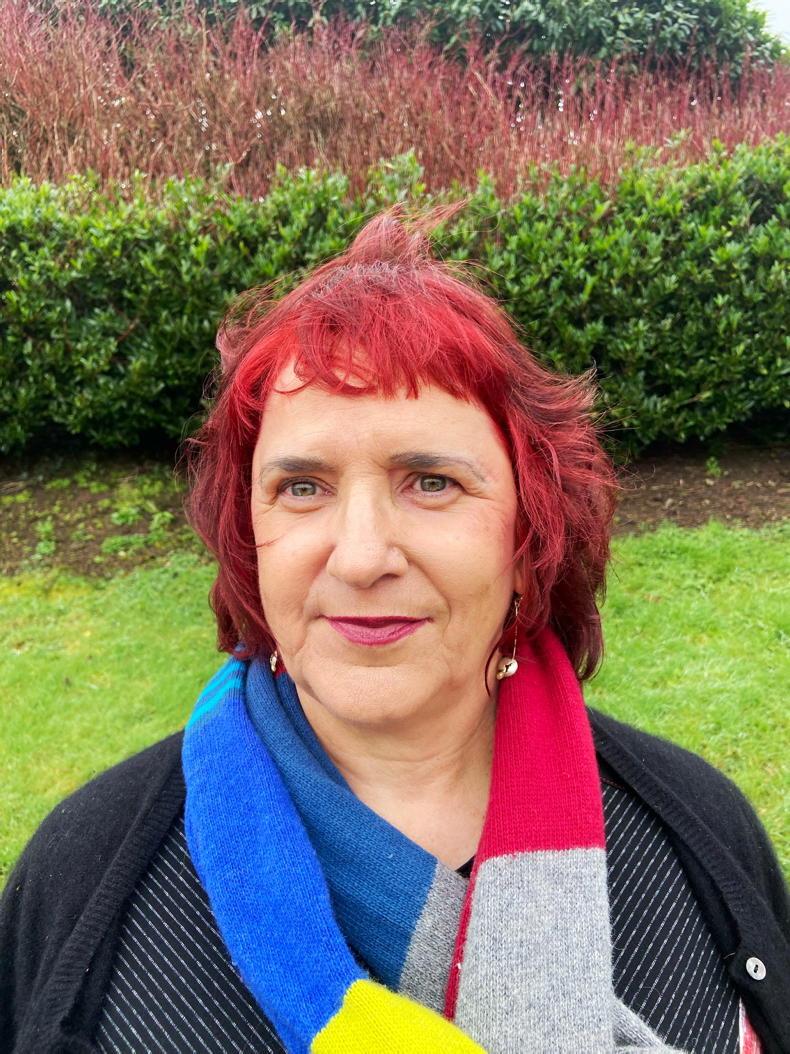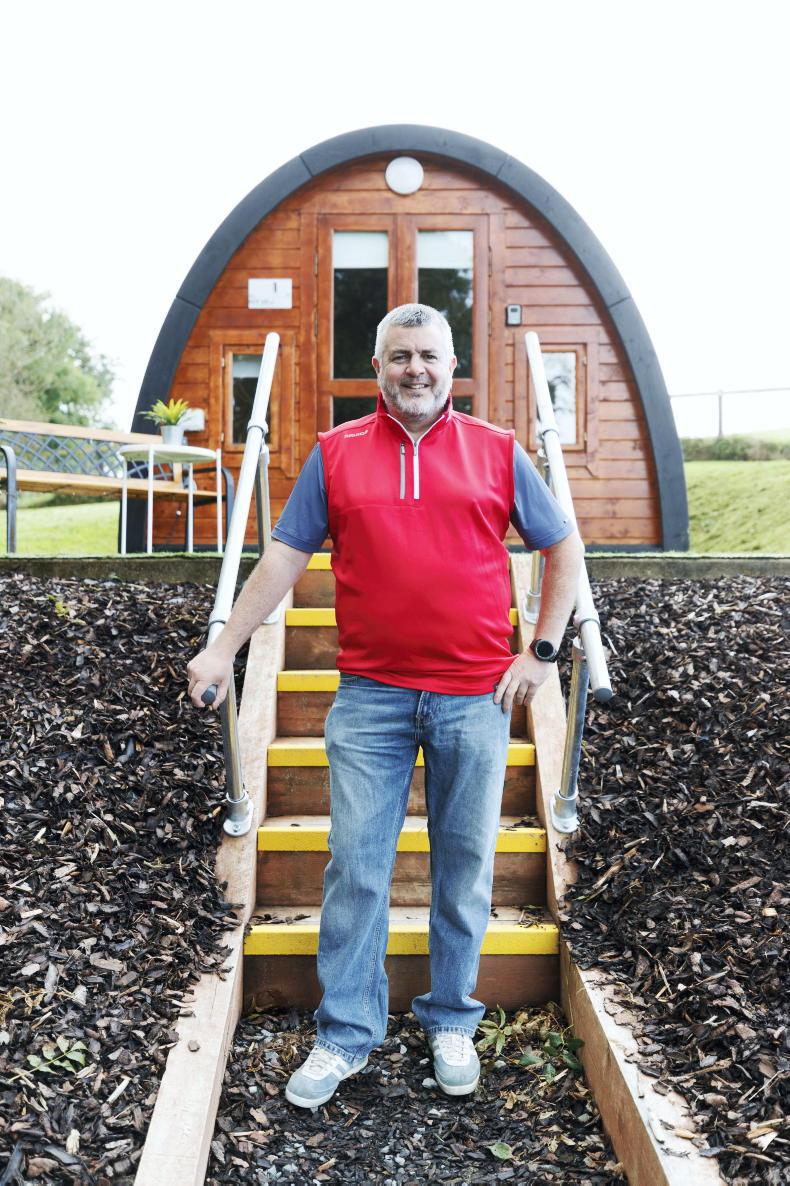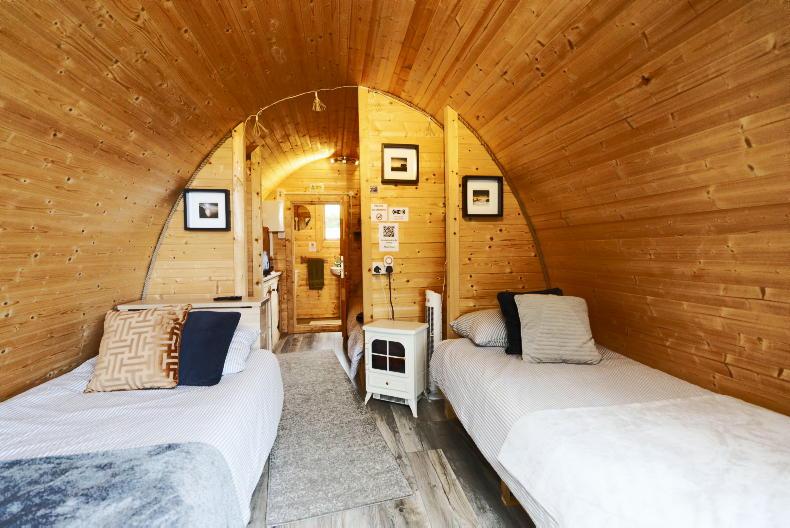Established agritourism businesses have seen success over the years, but for those interested in on-farm self-catering accommodation, there is much to consider. Glamping in particular has become a popular accommodation option in recent years with experiences ranging from basic and low-cost to high-end and luxurious (with a much higher price point).
Máire Ní Mhurchú, chair of the Irish Self Catering Federation (ISCF), tells Irish Country Living that since the pandemic, tourists’ priorities have changed in many ways; providing almost anyone with the space opportunities to create something special.
“Instead of wanting five-star luxury, the luxury is now space, fresh air and being immersed in nature,” she says. “If you can offer that, people are willing to pay for it. And that’s why people are willing to pay quite a lot for glamping, because it immerses them completely in nature.”
On-farm self-catering accommodation not only has the potential to bring supplementary income to your farm – it also brings benefits to your wider community as guests visit local pubs, restaurants and attractions during their stay.
“Depending on where the farm is, there may be areas you can use for the views, offer hillwalking or work with other facilities nearby,” Máire says.
“You’ve got to capitalise on what you’ve got. Work with locals who offer visitor experiences. We recommend a few farmers talk about it together – if you have three farming neighbours and you all want to introduce glamping, they aren’t in competition with you. If you each have 10 units, you’ve now created a destination.”
Why so few?
If on-farm glamping is deemed a viable way to diversify, why are there so few glamping options in Ireland? Máire says it all comes down to one thing: planning permission.
“If you look to Northern Ireland and compare it to the south, there are tons of glamping options. Historically, we have been at a standstill [for at least 10 years] because of planning legislation.
“Around the country, farmers are being knocked down from getting glamping going because they are designated as agricultural lands and there isn’t any allowance for alterations to that. But we also have rent pressure zones in 76% of the country.
“Let’s say you want to set up a glamping business on the scenic Ring of Kerry – you wouldn’t be allowed, because that is a rent pressure zone. Near Westport? The same problem. The whole of Co Limerick and Waterford are designated rent pressure zones. Now they have their greenways, but no accommodation to go with it. They are not giving permission because they want accommodation to go back into long-term housing stock.”

Máire Ní Mhurchú is chair of the Irish Self Catering Federation (ISCF).
Housing for All
These planning permission woes will hopefully be sorted this year on the back of a new registration system for short-term letters in Ireland. The system, called the Short Term Letting Register (STLR), is being brought in via Fáilte Ireland. Under this system, any letting offering stays of up to 21 consecutive days will need to be registered. This is part of the Government’s Housing for All initiative, which aims to develop regulatory controls to ensure that houses are used to best effect in areas of high housing demand.
Under this, Fáilte Ireland estimates that up to 12,000 properties could be brought back into the long-term rental market. Máire hopes this new system will bring much-needed clarity around glamping and self-catering rentals throughout Ireland.
“There will be new rules around who needs planning and these will clearly state who can set up a glamping business and who can’t. We will know more before the summer.”
Supports
You need public liability insurance for any glamping site in Ireland, but the type of accommodation you have will dictate how easily you become insured.
“If you decide you’re putting tents up, you’re not likely to get insurance,” Máire says. “It has to be a more permanent structure. Go for a purpose-built unit, make sure they are able for the weather in Ireland and put utilities in before you put them on site.”
It’s also recommended to become quality assured, either through Fáilte Ireland or the ISCF, though it is not yet a legal requirement. In terms of supports, Teagasc regularly host webinars and offer workshops on agritourism, while the Local Enterprise Office, the Sustainable Energy Authority of Ireland (SEAI), LEADER and county councils can all offer potential grants and supports.
In the meantime, Máire and the ISCF offer information, training and consultancy services to anyone considering taking the leap into self-catering accommodation. Check out iscf.ie
Department of housing
Irish Country Living reached out to the Department of Housing, Local Government and Heritage to ask why so few are granted planning permission to start self-catering or agritourism businesses. This was their response:
“The assessment and determination of planning applications (including in respect of proposals for glamping pods) is entirely a matter for the relevant Local Authority. Applications will be guided by the zonings, policies and objectives of the land use plan approved by their elected members in the local development plan. This provides guidance on the appropriateness of particular uses in certain locations.
In addition, a significant number of other matters are considered during the assessment of planning applications, including generation of additional traffic and safety of access, visual impact, safe and effective disposal of sewerage, water supply, landscape and habitat impacts.
As with all planning proposals, the Development Management Guidelines 2007 strongly recommend that prospective applicants engage with planning authorities through the pre-planning process prior to lodgement of planning applications to determine particular issues which may arise and to consider how any concerns may be addressed as a part of the planning application.”

Alan Vaughan. / Eamon Ward
Alan Vaughan, who is based in Co Clare, owns and operates Ivy Hill Glamping on his 65ac drystock farm. Being situated just outside of Lahinch, he says business built up slowly after opening in 2021 but soon increased in popularity, even with just one pod on offer. Ivy Hill’s amenities include a flat screen TV, one three-bed bedroom and a kitchenette.
“All of a sudden, I remember, we had five bookings – just one after another – on a Sunday afternoon. Most people stay just one night while they’re en route south, to Kerry, or north, to Galway. I often see guests check in at 8pm and leave early the next day to explore the area [before moving on].”
Alan’s glamping pod is situated in what was one of his lesser-used fields. While he still keeps beef cattle, he says he has reduced the number of animals he farms as he spends time working on his agritourism business.
“It’s mostly run by myself,” he explains. “My wife works full-time. Check out time is 11am and check in is at 4pm, so the glamping business really fits in with my lifestyle.”
The people who stay at Ivy Hill are mostly international visitors, though Alan says he gets a good few Irish as well. Booking is done entirely through the website booking.com. When designing the pod, it was important for him to make it an inclusive place for families.
“It’s nice and private, there’s no hustle or bustle, we don’t get hens or stags – anyone who tends to go glamping is fairly quiet; we get a lot of families as I purposely built the pod to suit up to four people. That way you can have a family stay, or four friends, rather than just a pod for two.”

Alan's glamping pod includes two single and one double bed, as well as a kitchenette and a television. / Eamon Ward
Depending on your site, you might be suited for any number of units - whether it’s one or up to 10. Alan is happy with the level of profit he is making on his one pod, at this stage.
Expanding is something he might consider but he also says it’s important that it is a sensible business decision.
“It’s all about how you’re going to continue to manage [the business],” he says. “After all, if you get more pods, you’re more tied to it. You have to do the maths on it.”
For advice on glamping pods or for more information, you can find Alan on Instagram @glampingivyhill
Read more
Holiday at Home: one Coole castle in Fermanagh
Short-term rental bill causing difficulty in rural Ireland
Established agritourism businesses have seen success over the years, but for those interested in on-farm self-catering accommodation, there is much to consider. Glamping in particular has become a popular accommodation option in recent years with experiences ranging from basic and low-cost to high-end and luxurious (with a much higher price point).
Máire Ní Mhurchú, chair of the Irish Self Catering Federation (ISCF), tells Irish Country Living that since the pandemic, tourists’ priorities have changed in many ways; providing almost anyone with the space opportunities to create something special.
“Instead of wanting five-star luxury, the luxury is now space, fresh air and being immersed in nature,” she says. “If you can offer that, people are willing to pay for it. And that’s why people are willing to pay quite a lot for glamping, because it immerses them completely in nature.”
On-farm self-catering accommodation not only has the potential to bring supplementary income to your farm – it also brings benefits to your wider community as guests visit local pubs, restaurants and attractions during their stay.
“Depending on where the farm is, there may be areas you can use for the views, offer hillwalking or work with other facilities nearby,” Máire says.
“You’ve got to capitalise on what you’ve got. Work with locals who offer visitor experiences. We recommend a few farmers talk about it together – if you have three farming neighbours and you all want to introduce glamping, they aren’t in competition with you. If you each have 10 units, you’ve now created a destination.”
Why so few?
If on-farm glamping is deemed a viable way to diversify, why are there so few glamping options in Ireland? Máire says it all comes down to one thing: planning permission.
“If you look to Northern Ireland and compare it to the south, there are tons of glamping options. Historically, we have been at a standstill [for at least 10 years] because of planning legislation.
“Around the country, farmers are being knocked down from getting glamping going because they are designated as agricultural lands and there isn’t any allowance for alterations to that. But we also have rent pressure zones in 76% of the country.
“Let’s say you want to set up a glamping business on the scenic Ring of Kerry – you wouldn’t be allowed, because that is a rent pressure zone. Near Westport? The same problem. The whole of Co Limerick and Waterford are designated rent pressure zones. Now they have their greenways, but no accommodation to go with it. They are not giving permission because they want accommodation to go back into long-term housing stock.”

Máire Ní Mhurchú is chair of the Irish Self Catering Federation (ISCF).
Housing for All
These planning permission woes will hopefully be sorted this year on the back of a new registration system for short-term letters in Ireland. The system, called the Short Term Letting Register (STLR), is being brought in via Fáilte Ireland. Under this system, any letting offering stays of up to 21 consecutive days will need to be registered. This is part of the Government’s Housing for All initiative, which aims to develop regulatory controls to ensure that houses are used to best effect in areas of high housing demand.
Under this, Fáilte Ireland estimates that up to 12,000 properties could be brought back into the long-term rental market. Máire hopes this new system will bring much-needed clarity around glamping and self-catering rentals throughout Ireland.
“There will be new rules around who needs planning and these will clearly state who can set up a glamping business and who can’t. We will know more before the summer.”
Supports
You need public liability insurance for any glamping site in Ireland, but the type of accommodation you have will dictate how easily you become insured.
“If you decide you’re putting tents up, you’re not likely to get insurance,” Máire says. “It has to be a more permanent structure. Go for a purpose-built unit, make sure they are able for the weather in Ireland and put utilities in before you put them on site.”
It’s also recommended to become quality assured, either through Fáilte Ireland or the ISCF, though it is not yet a legal requirement. In terms of supports, Teagasc regularly host webinars and offer workshops on agritourism, while the Local Enterprise Office, the Sustainable Energy Authority of Ireland (SEAI), LEADER and county councils can all offer potential grants and supports.
In the meantime, Máire and the ISCF offer information, training and consultancy services to anyone considering taking the leap into self-catering accommodation. Check out iscf.ie
Department of housing
Irish Country Living reached out to the Department of Housing, Local Government and Heritage to ask why so few are granted planning permission to start self-catering or agritourism businesses. This was their response:
“The assessment and determination of planning applications (including in respect of proposals for glamping pods) is entirely a matter for the relevant Local Authority. Applications will be guided by the zonings, policies and objectives of the land use plan approved by their elected members in the local development plan. This provides guidance on the appropriateness of particular uses in certain locations.
In addition, a significant number of other matters are considered during the assessment of planning applications, including generation of additional traffic and safety of access, visual impact, safe and effective disposal of sewerage, water supply, landscape and habitat impacts.
As with all planning proposals, the Development Management Guidelines 2007 strongly recommend that prospective applicants engage with planning authorities through the pre-planning process prior to lodgement of planning applications to determine particular issues which may arise and to consider how any concerns may be addressed as a part of the planning application.”

Alan Vaughan. / Eamon Ward
Alan Vaughan, who is based in Co Clare, owns and operates Ivy Hill Glamping on his 65ac drystock farm. Being situated just outside of Lahinch, he says business built up slowly after opening in 2021 but soon increased in popularity, even with just one pod on offer. Ivy Hill’s amenities include a flat screen TV, one three-bed bedroom and a kitchenette.
“All of a sudden, I remember, we had five bookings – just one after another – on a Sunday afternoon. Most people stay just one night while they’re en route south, to Kerry, or north, to Galway. I often see guests check in at 8pm and leave early the next day to explore the area [before moving on].”
Alan’s glamping pod is situated in what was one of his lesser-used fields. While he still keeps beef cattle, he says he has reduced the number of animals he farms as he spends time working on his agritourism business.
“It’s mostly run by myself,” he explains. “My wife works full-time. Check out time is 11am and check in is at 4pm, so the glamping business really fits in with my lifestyle.”
The people who stay at Ivy Hill are mostly international visitors, though Alan says he gets a good few Irish as well. Booking is done entirely through the website booking.com. When designing the pod, it was important for him to make it an inclusive place for families.
“It’s nice and private, there’s no hustle or bustle, we don’t get hens or stags – anyone who tends to go glamping is fairly quiet; we get a lot of families as I purposely built the pod to suit up to four people. That way you can have a family stay, or four friends, rather than just a pod for two.”

Alan's glamping pod includes two single and one double bed, as well as a kitchenette and a television. / Eamon Ward
Depending on your site, you might be suited for any number of units - whether it’s one or up to 10. Alan is happy with the level of profit he is making on his one pod, at this stage.
Expanding is something he might consider but he also says it’s important that it is a sensible business decision.
“It’s all about how you’re going to continue to manage [the business],” he says. “After all, if you get more pods, you’re more tied to it. You have to do the maths on it.”
For advice on glamping pods or for more information, you can find Alan on Instagram @glampingivyhill
Read more
Holiday at Home: one Coole castle in Fermanagh
Short-term rental bill causing difficulty in rural Ireland










 This is a subscriber-only article
This is a subscriber-only article










SHARING OPTIONS: